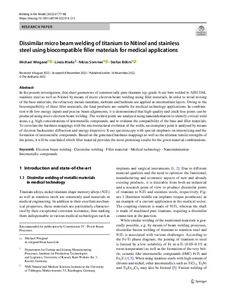| dc.date.accessioned | 2023-01-27T15:11:25Z | |
| dc.date.available | 2023-01-27T15:11:25Z | |
| dc.date.issued | 2022-11-16 | |
| dc.identifier | doi:10.17170/kobra-202301267422 | |
| dc.identifier.uri | http://hdl.handle.net/123456789/14389 | |
| dc.description.sponsorship | Gefördert im Rahmen des Projekts DEAL | ger |
| dc.language.iso | eng | eng |
| dc.rights | Namensnennung 4.0 International | * |
| dc.rights.uri | http://creativecommons.org/licenses/by/4.0/ | * |
| dc.subject | electron beam welding | eng |
| dc.subject | dissimilar welding | eng |
| dc.subject | filler material | eng |
| dc.subject | medical technology | eng |
| dc.subject | nanoindentation | eng |
| dc.subject | intermetallic compounds | eng |
| dc.subject.ddc | 600 | |
| dc.subject.ddc | 660 | |
| dc.title | Dissimilar micro beam welding of titanium to Nitinol and stainless steel using biocompatible filler materials for medical applications | eng |
| dc.type | Aufsatz | |
| dcterms.abstract | In the present investigation, thin sheet geometries of commercially pure titanium (cp, grade 4) are butt-welded to AISI 316L stainless steel as well as Nitinol by means of micro electron beam welding using filler materials. In order to avoid mixing of the base materials, the refractory metals tantalum, niobium and hafnium are applied as intermediate layers. Owing to the biocompatibility of these filler materials, the final products are suitable for medical technology applications. In combination with low energy inputs and precise beam alignments, it is demonstrated that high-quality and crack-free joints can be produced using micro electron beam welding. The welded joints are analysed using nanoindentation to identify critical weld areas, e.g. high concentrations of intermetallic compounds, and to evaluate the compatibility of the base and filler materials. To correlate the hardness mappings with the microstructural evolution of the welds, an exemplary joint is analysed by means of electron backscatter diffraction and energy dispersive X-ray spectroscopy with special emphasis on intermixing and the formation of intermetallic compounds. Based on the generated hardness mappings as well as the ultimate tensile strengths of the joints, it will be concluded which filler material provides the most promising results for the given material combinations. | eng |
| dcterms.accessRights | open access | |
| dcterms.creator | Wiegand, Michael | |
| dcterms.creator | Marks, Linda | |
| dcterms.creator | Sommer, Niklas | |
| dcterms.creator | Böhm, Stefan | |
| dc.relation.doi | doi:10.1007/s40194-022-01412-3 | |
| dc.subject.swd | Elektronenstrahlschweißen | ger |
| dc.subject.swd | Füllstoff | ger |
| dc.subject.swd | Titan | ger |
| dc.subject.swd | Nitinol | ger |
| dc.subject.swd | Edelstahl | ger |
| dc.subject.swd | Medizintechnik | ger |
| dc.subject.swd | Nanometerbereich | ger |
| dc.subject.swd | Intermetallische Verbindungen | ger |
| dc.type.version | publishedVersion | |
| dcterms.source.identifier | eissn:1878-6669 | |
| dcterms.source.issue | Issue 1 | |
| dcterms.source.journal | Welding in the World | eng |
| dcterms.source.pageinfo | 77-88 | |
| dcterms.source.volume | Volume 67 | |
| kup.iskup | false | |


